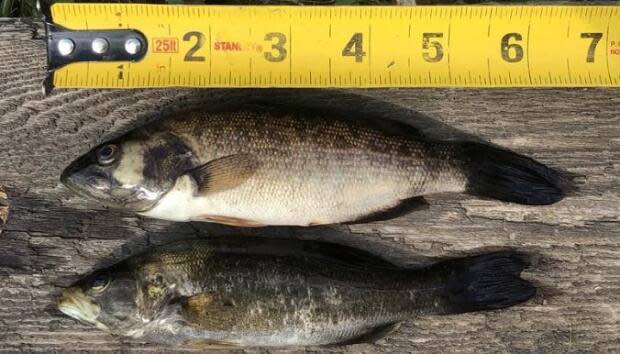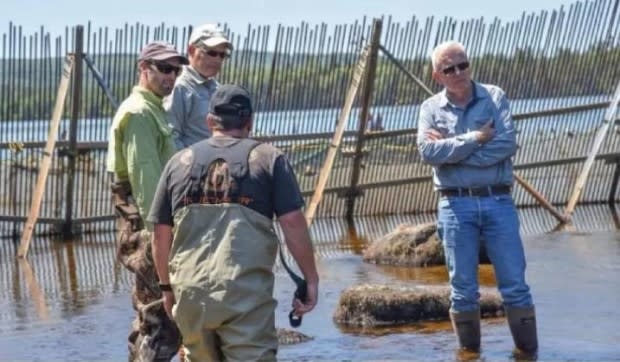Cottage owners try to stop fish kill in Miramichi Lake
A group of cottage owners is making a last-ditch pitch to federal Fisheries Minister Bernadette Jordan in hopes of stopping or delaying a plan to eradicate fish in Miramichi Lake this September. The proposal would see the fish killer rotenone applied to the lake, a nearby brook, and a 15-kilometre section of the Miramichi River in an attempt to eradicate smallmouth bass, an invasive species viewed as a serious threat to young Atlantic salmon. Rotenone kills fish within minutes. It has been effective in erasing invasive fish populations elsewhere in North America, although more than one application is sometimes required. A coalition of First Nations and salmon conservation organizations filed the application, which would see almost all fish in the lake killed, with native fish later repopulating naturally or being transplanted from elsewhere. The plan is awaiting DFO approval. Rotenone is made from the root of certain bean plants, it is poisonous to fish but biodegrades in water over a period of two weeks to 30 days or more depending on conditions.
Bass are aggressive competitors for food

Smallmouth are not native anywhere in Atlantic Canada. They appeared in Miramichi Lake about a decade ago, possibly after being introduced illegally by anglers. Attempts since then to eradicate them through electrofishing and other methods have failed. The Miramichi River itself is connected to the nearby lake by a small brook. Bass were discovered in the river in August 2019, leading to an expansion of the eradication plan to include the use of rotenone in the brook and river. Salmon groups worry if the bass become established in the river, they will feed on Atlantic salmon young further threatening an already stressed population.
The letter, signed by cottage owner Trish Foster, raises concerns about "significant" environmental, health and welfare impacts and asks for an opportunity to speak to the science content of the application along with the decision process being used. "Are we worried about the declining population of the salmon? Obviously, yes," said Foster in an interview with CBC. "But what we're saying is that we don't think that a nuclear bomb being dropped in our lake and Miramichi River is the solution." The provincial Department of Environment initially waived requirements for an environmental impact assessment of the plan to treat Miramichi Lake.
No provincial decision has been made on the amended application to include treatment of the brook and river.
Demands an EIA
Foster wants to see an environmental impact assessment.
"If poisoning an entire lake and 15 kilometres of a river doesn't trigger an environmental impact assessment, what does?" she said. Foster is also worried about other ingredients, including petroleum distillates, contained in Noxfish, the rotenone product the proponents plan to use. There are about 16 cottages on or near the 6,000-acre lake. Most are concentrated at one end. Owners would be prevented from visiting the lake during and immediately after the application. Adult invertebrates are not expected to be affected, nor are birds and insects.

Proponents say other invertebrates and zooplankton in Miramichi Lake are expected to recover by the following spring or summer.
A plan is being prepared to capture Atlantic salmon in the targeted stretch of the Southwest Miramichi in advance and hold them in a tributary during the Rotenone treatment. The cottagers group is concerned the fish killer will have to be applied to the lake more than once, as has happened in some cases in the U.S. But Neville Crabbe of the Atlantic Salmon Federation, one of the groups behind the plan, says lessons have since been learned about rotenone. He points to more recent applications in British Columbia's Thompson River Valley, where 12 lakes were treated to eliminate invasive smallmouth bass and yellow perch without incident. "This is really a conservation action," said Crabbe. "There's no motive other than to safeguard the diversity and integrity of the Miramichi River ecosystem." He said rotenone has been approved by Health Canada's pest management regulatory agency, and that other ingredients in Noxfish are "inert."
No decision from DFO yet
"You know I think it would be a lot different if we were proposing to use a product that had not been extensively reviewed and approved by Health Canada, but in this case we are." Partners in the project were told Monday by Fisheries and Oceans Canada that more time is required to complete the department's consultation with First Nations before a decision on the rotenone plan can be made. In a statement to CBC, Fisheries and Oceans Canada said a decision on the application will be made "by late summer/fall", a timeframe that could threaten plans to treat the lake and river in 2020. Due to water temperature and flow, the optimum time for rotenone application in the Miramichi area is September.
The statement says consultation is currently underway with Indigenous communities.
DFO must "take into consideration public safety, impacts to fish and fish habitat, the effectiveness of alternate measures, vessel and mariner safety, and other regulatory requirements," the statement says.


